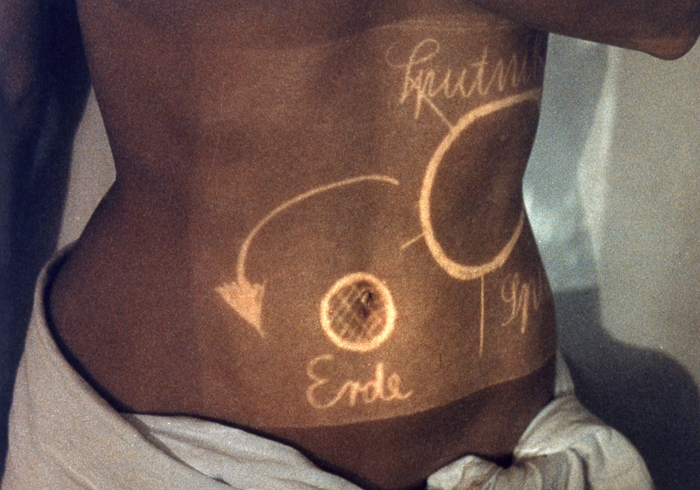That transformation was a lifelong concern for the late Austrian artist Birgit Jürgenssen is apparent in her recently reappraised work from the 1970s: high heels emerge like weaponised nipples from unexpected places on her body, vaginas sprout in the crevices of books and shoes morph into animals. This taster of the artist’s output from the 1980s and 90s, however, reveals how her direct takes on female identity and metamorphosis evolved into something dreamier and more abstract. The suffering housewives of her earlier drawings, photos and performances are replaced by shapeshifters, as in a swirling New Age-y painting of a moon goddess (in Three sources of nocturnal light (Angel, Moon, Torch), 1987) and a photo-diptych of crumpled fabric shining like molten gold (Untitled, 1988).
This diverse body of work is united by its nocturnal atmosphere. Scenes in paintings and photographs are illuminated by milky moonlight or amber dawn, or more often by the harsh electric lighting that gives shadowy, cheaply shot film noir its identity. This makes it less of a surprise – given her feminist allegiances – to discover in Jürgenssen’s writings that she was a fan of Raymond Chandler. His novels, which she loved for their directness and irony (and presumably despite their gender archetypes), fill a bookcase designed by the artist and inlaid with photos of eyes, mouths and lights. They lend the neighbouring Untitled (1996), a grid of 12 photos in which a nude woman is silhouetted against a window, a sinister, detective-story vibe. Inside and outside are muddled: am I her lover watching from across the room, or a voyeur documenting her movements from the street? Though her stretching limbs suggest a semaphore-style code, she remains an unknowable outline.
This interest in dissembling binaries – self and other, object and image, dark and light, soft and hard – is a constant theme of the exhibition. Photos are placed within sculptures that underline both their illusionistic and physical properties, and add a tactile dimension. In a series of untitled triptychs (1988–90), prints are wrapped in gauzy fabric (so their imagery is partially obscured) and set in steel frames. Elsewhere, a hinged metal case opens to reveal, on one side, an image of a flower, and on the other, its darkened reflection. Titled Narcissus and Echo (1991), it emphasises reflections of reflections of the world via photographic and mirror images, suggesting a self-enclosed system in which the image has become disconnected from reality. Given her early challenge to the gap between socially imposed feminine ideals and women’s experiences, these boxes might suggest art as a space free from life’s constraints.
The four 1988 Untitled (Body projection) photos that, lining a corridor, both open and close the exhibition, take the muddling of perceived boundaries further still. Using simple projections of insubstantial shadows and light, Jürgenssen’s skin becomes the surface for a constellation of stars, tiny bouncing kangaroos, writing and abstract blobs. Melding with other signs, her body cannot easily be read as ‘woman’. It’s as if such categories dissolve before our eyes.
Birgit Jürgenssen: Nocturnal Light at Alison Jacques Gallery, London, 17 April – 19 May 2018
From the Summer 2018 issue of ArtReview
